Minnesota, known as the ‘Land of 10,000 Lakes’, is a haven for birdwatchers and nature enthusiasts alike. This comprehensive guide not only provides detailed information on the different species of blue birds found in the region but also includes a free photo guide to help you identify and appreciate the subtle differences in blue colors and markings.
Whether you are a seasoned birdwatcher or a beginner looking to start your journey, this guide will be an indispensable companion in your exploration of the beautiful blue-colored birds of Minnesota.
Blue Birds Found In Minnesota
This diverse geography provides a wide range of habitats for birds, making it a hotspot for birdwatching. The different ecosystems attract various species of birds, from waterfowl and shorebirds that frequent the lakes and wetlands to songbirds that inhabit the forests and prairies. Additionally, Minnesota is located along major migratory routes year-round, which means that a variety of birds pass through the state during their seasonal migrations. This, combined with the fact that the state experiences all four seasons, makes for a rich and diverse bird population, including a variety of blue birds.
Western Bluebird
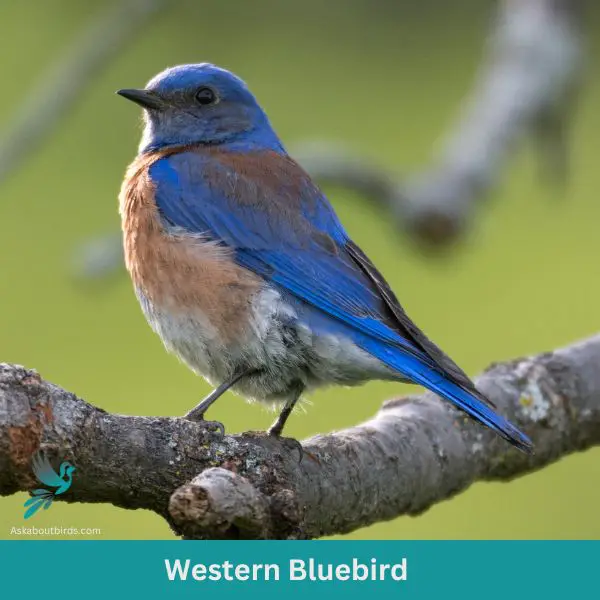
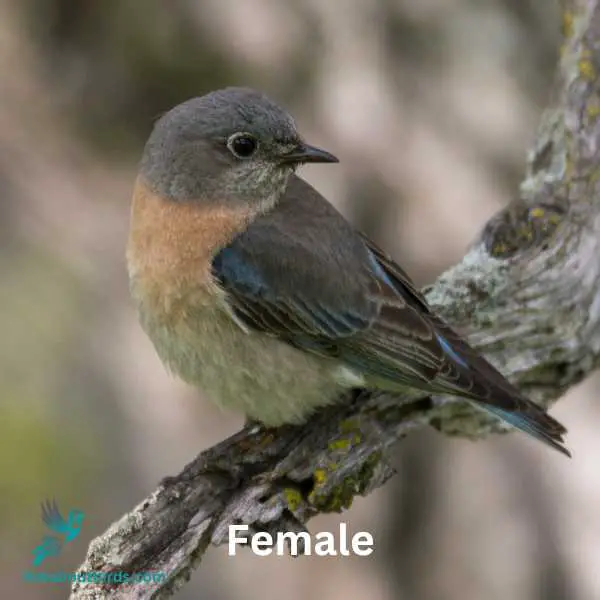
| Trait | Western Bluebird |
|---|---|
| Scientific Name | Sialia mexicana |
| Length | 5.5-7 inches |
| Wingspan | 11-13 inches |
| Weight | 0.8-1.1 ounces |
The Western Bluebird is a charismatic bird, appreciated for its vivid coloring and melodious song, commonly observed in open woodlands and meadows of the West.
Appearance: The male Western Bluebird sports a dark blue head, throat, wings, and tail with an orange breast and sides, transitioning into a grayish belly. Females are more muted, displaying grayish-blue wings and tail with a more subdued orange wash on the chest.
Diet: Western Bluebirds predominantly feed on insects, complemented by berries and fruits when available. They hunt by perching and then diving to the ground to capture their prey, and they’re also known to catch insects in mid-air.
Reproduction: These birds often utilize natural tree cavities or nest boxes for breeding. The female builds a loose nest inside and lays a clutch of 4-6 pale blue eggs.
Eastern Bluebird
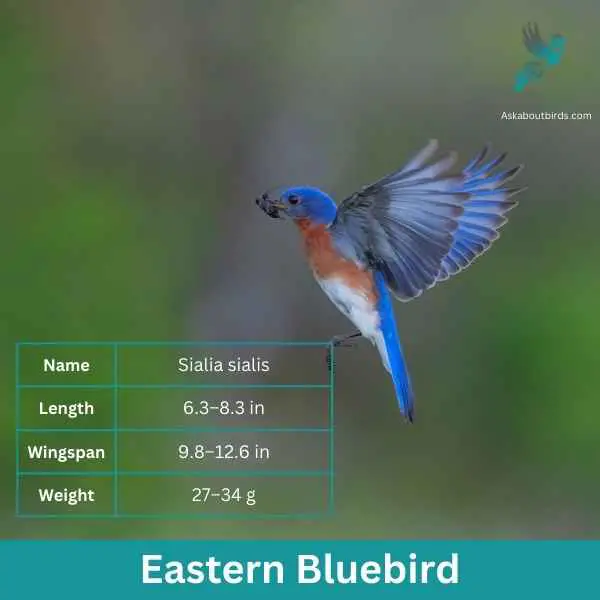
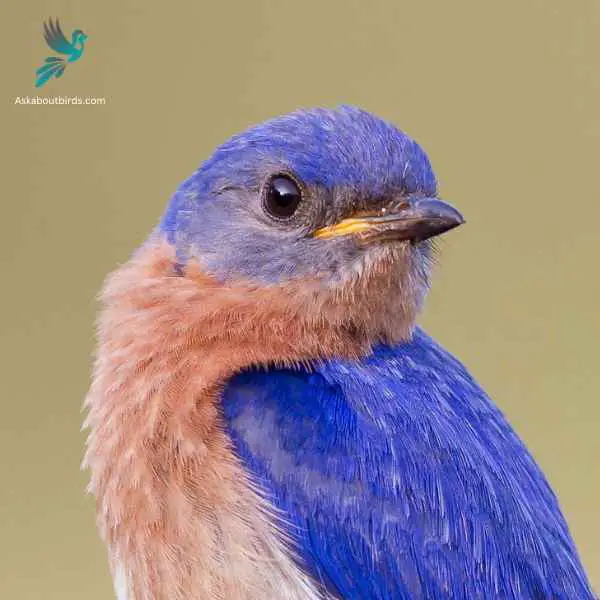
| Feature | Measurement |
|---|---|
| Scientific Name | Sialia sialis |
| Length | 6.3–8.3 in |
| Wingspan | 9.8–12.6 in |
| Weight | 27–34 g |
The Eastern Bluebird (Sialia sialis) is a small thrush found in open woodlands, farmlands, and orchards, and is recognized for its vibrant blue and red coloration. Male Eastern Bluebirds are dazzling with bright blue upperparts and a rusty or brick-red throat and breast, while females, though less colorful, still offer a similar pattern. The bird is native to North America and is commonly seen east of the Rockies, from Canada to the Gulf States and southeastern Arizona to Nicaragua.
Eastern Bluebirds feed on insects, wild fruit and berries. They have a gentle nature and are often seen perched alone or in small groups in the open, scanning the ground for prey. They are cavity nesters and will use old woodpecker holes or birdhouses if they are the right size.
Mountain Bluebird
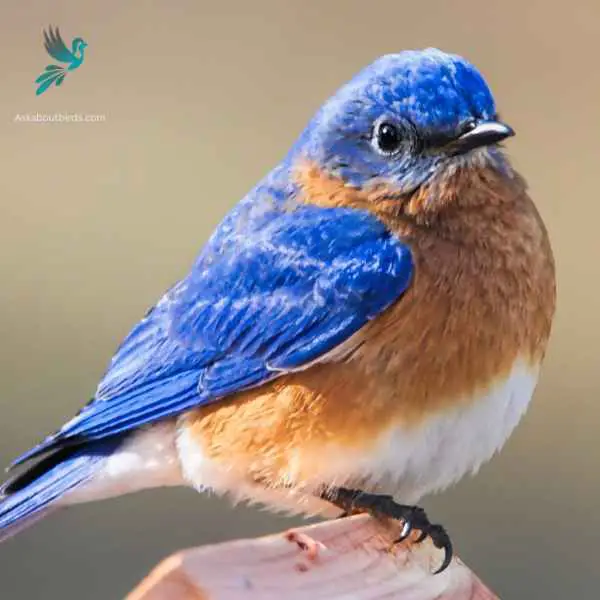
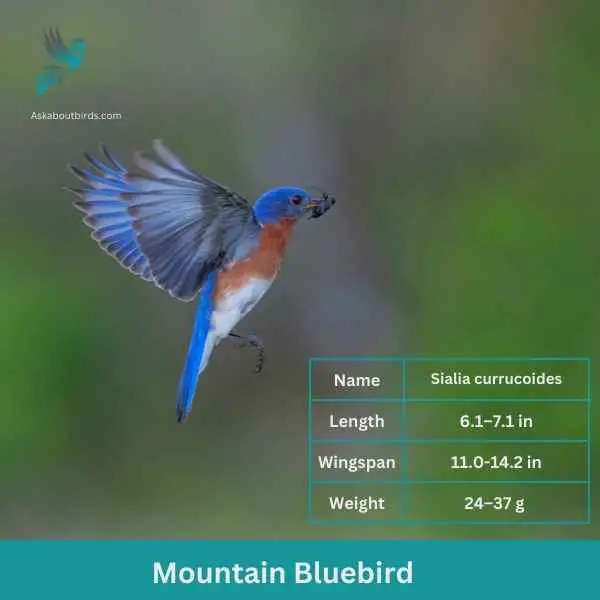
| Feature | Measurement |
|---|---|
| Scientific Name | Sialia currucoides |
| Length | 6.1–7.1 in |
| Wingspan | 11.0-14.2 in |
| Weight | 24–37 g |
The Mountain Bluebird is a small bird found in open grasslands and rocky mountains of North America. It is known for its stunning blue plumage, which is particularly vibrant in males. Females, on the other hand, have a more subdued blue coloration with hints of gray. These birds have slender bodies and a slightly curved bill, adapted for catching insects on the wing.
Mountain Bluebirds are insectivores, feeding primarily on insects such as beetles, grasshoppers, and spiders. They are skilled aerial hunters, capable of capturing their prey in mid-flight. During breeding season, these birds build their nests in tree cavities or man-made nest boxes, where females lay a clutch of eggs. The male bluebird actively participates in nest-building and provides food for the female during incubation.
Indigo Bunting


| Feature | Measurement |
|---|---|
| Scientific Name | Passerina cyanea |
| Length | 4.5–5.1 in |
| Wingspan | 7.1–9.1 in |
| Weight | 11.2–21.4 g |
The Indigo Bunting is a strikingly vibrant songbird, often hailed for its brilliant blue plumage and melodic song that graces woodlands and meadows during the warmer months.
Appearance: Males are renowned for their bright indigo blue feathers, which can appear darker in certain lights. Females and juveniles, on the other hand, are brown with subtle hints of blue on their wings and tail. The species lacks the vibrant streaking or spotting commonly found in many other songbirds.
Diet: Indigo Buntings primarily subsist on seeds, especially during non-breeding seasons. During the breeding season, they also consume a variety of insects such as beetles, caterpillars, and spiders, providing essential protein for their growing chicks.
Reproduction: Indigo Buntings build their nests close to the ground in shrubs or low tree branches. These nests, crafted meticulously with grasses and other plant materials, cradle clutches of typically 3 to 4 eggs. After hatching, the young are fed by both parents until they’re ready to fledge.
Lazuli Bunting
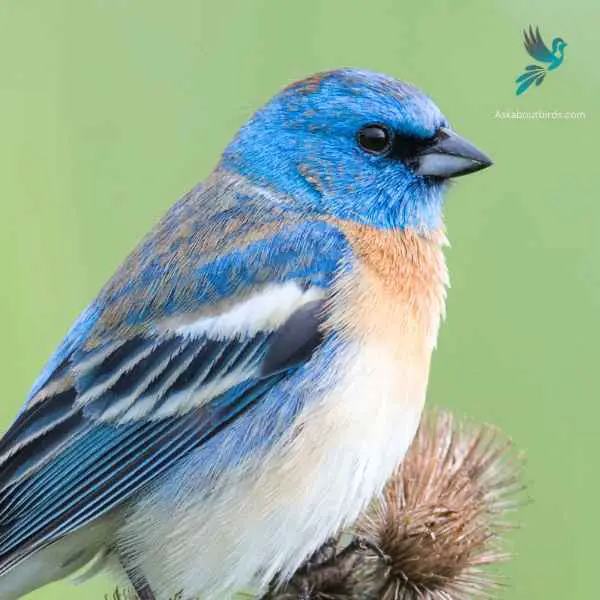

| Feature | Measurement |
|---|---|
| Scientific Name | Passerina amoena |
| Length | 5.1-5.9 in |
| Wingspan | 8.7 in |
| Weight | 13-18 g |
The Lazuli Bunting is a vibrant songbird recognized for its brilliant colors and melodious song, frequently seen in brushy areas and woodlands during the summer months.
Appearance: The male boasts a dazzling bright blue head and back, offset by a white belly and rust-orange breast. Females and immature birds present a more muted brownish hue overall, with a hint of blue on the wings and tail.
Diet: Lazuli Buntings primarily feed on seeds, but during the breeding season, they’ll also consume insects. Their strong, conical beaks are perfectly adapted for seed-cracking.
Reproduction: The female Lazuli Bunting constructs a cup-shaped nest using grasses, twigs, and other fine materials, often placing it in a shrub or low tree. She typically lays a clutch of 3-4 pale blue or white eggs.
Florida Scrub-Jay
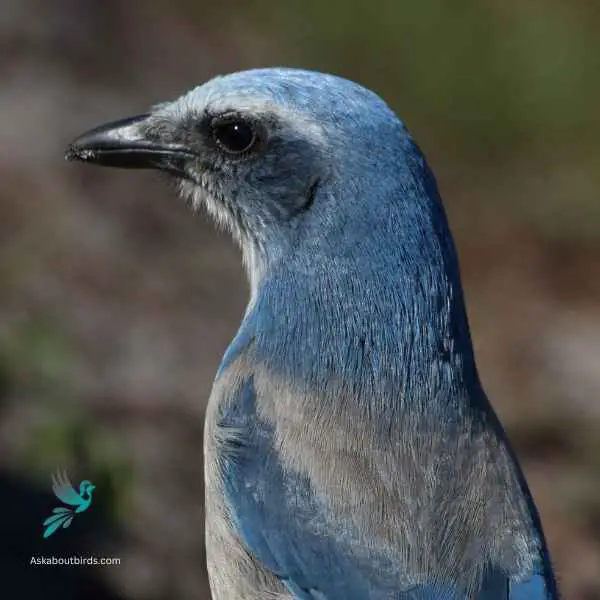
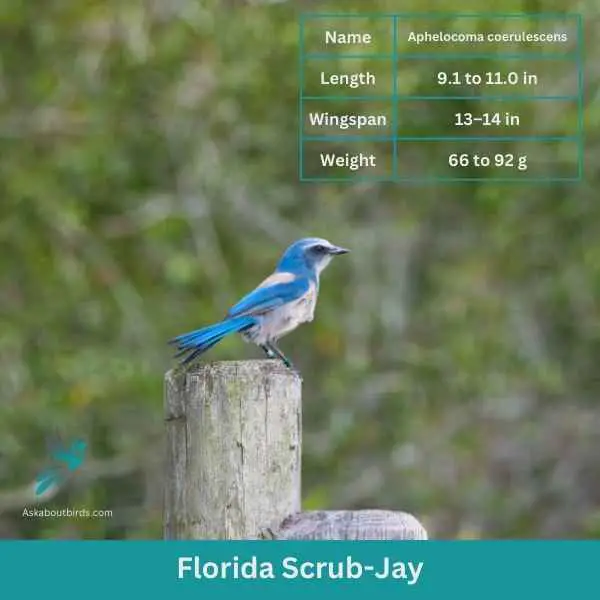
| Feature | Measurement |
|---|---|
| Scientific Name | Aphelocoma coerulescens |
| Length | 9.1 to 11.0 in |
| Wingspan | 13–14 in |
| Weight | 66 to 92 g |
The Florida Scrub-Jay is a striking, cooperative-breeding bird endemic to the sandy scrublands of Florida. It stands out as the only species of bird restricted entirely to the state of Florida.
Appearance: The Florida Scrub-Jay exhibits a bright blue head, wings, and tail, contrasting with its pale gray underbelly and nape. Its stout bill, legs, and eyes are black. Unlike other jays, it lacks a crest on its head.
Diet: Primarily, the diet of the Florida Scrub-Jay consists of a variety of insects and small animals, seeds, and especially acorns. They have a unique behavior of storing thousands of acorns, burying them in the ground as a food reserve for the lean winter months.
Reproduction: These jays are monogamous and often form family groups. They typically nest in shrubs or low trees. The nest, built primarily by the female, is made of twigs and lined with fine plant material. The female lays a clutch of 3 to 4 eggs, which are pale greenish or bluish and spotted with brown.
Blue Jay

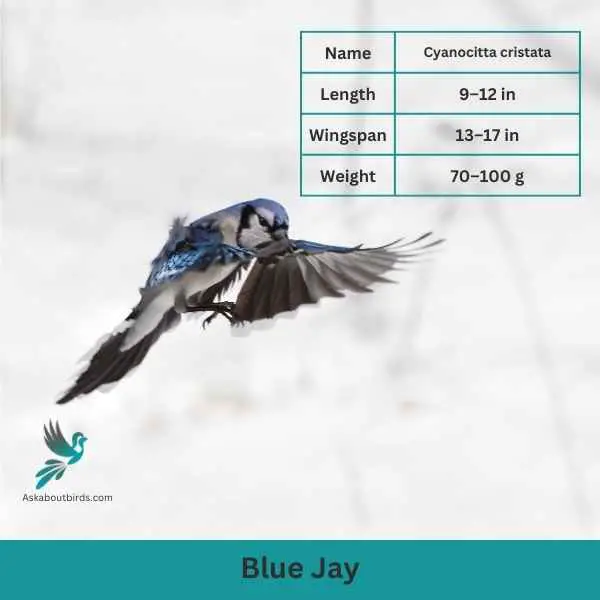
| Feature | Measurement |
|---|---|
| Scientific Name | Cyanocitta cristata |
| Length | 9–12 in |
| Wingspan | 13–17 in |
| Weight | 70–100 g |
The Blue Jay is a vibrant and easily recognized bird, known for its intelligence, distinctive calls, and bold behavior, commonly found throughout the eastern and central United States.
Appearance: The Blue Jay sports a striking blue upper body with white and black markings. Its face has a pronounced white patch with a black necklace that runs across the throat and around the head. The bird also features a pronounced blue crest, which can be raised or lowered, and its wings and tail are brightly colored with black bars and white tips.
Diet: Blue Jays are omnivores. Their diet consists primarily of seeds, nuts, especially acorns, fruits, and small insects. They’ve also been known to eat eggs or nestlings of other birds occasionally. Blue Jays often store food items in caches to eat later.
Reproduction: Blue Jays are monogamous birds that form long-lasting pair bonds. They typically build their nests in trees or large shrubs, constructing them from twigs, grass, and sometimes using mud as a binder. The female lays a clutch of 3 to 6 eggs, which are pale blue or sometimes white with brown speckles.
Steller’s Jay
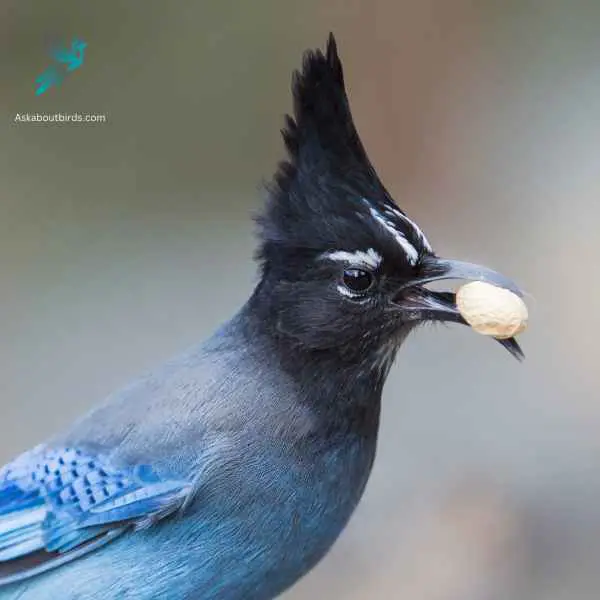

| Feature | Measurement |
|---|---|
| Scientific Name | Cyanocitta stelleri |
| Length | 12–13 in |
| Wingspan | 45 to 48 cm |
| Weight | 45 to 48 cm |
The Steller’s Jay is a charismatic and easily recognizable bird found mainly in the coniferous forests of the western North America, known for its bold behavior and loud, varied calls.
Appearance: The Steller’s Jay has a striking color contrast with a deep blue body and wings and a blackish head and upper body. One of its most distinguishing features is the tall, dark crest on its head, which can be raised or lowered depending on the bird’s mood. Its eyes are dark and its beak is strong and black.
Diet: The Steller’s Jay is omnivorous. It feeds on a wide range of items, from seeds, nuts, and berries to insects and small animals. It’s also known to raid campsites and picnics, often scavenging for human food.
Reproduction: Steller’s Jays form monogamous pairs that often remain together for several years. They typically build their nests in coniferous trees, made from twigs, moss, and other plant materials. The female lays a clutch of 2 to 6 eggs, which are usually pale green or blue with brown spots.
Blue Grosbeak
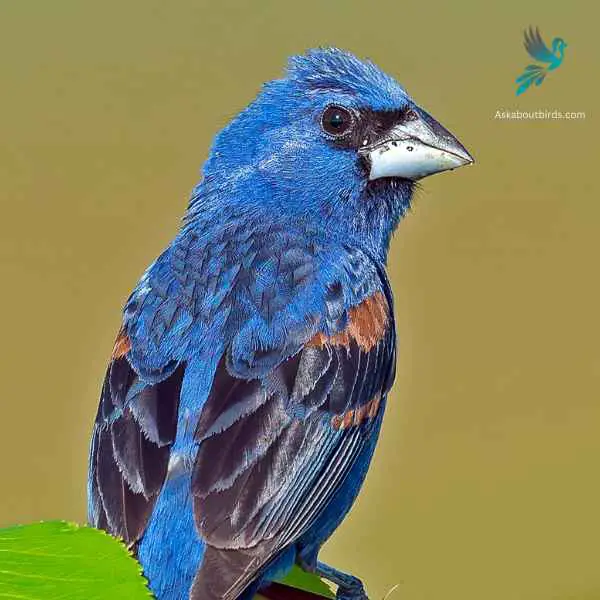

| Feature | Measurement |
|---|---|
| Scientific Name | Passerina caerulea |
| Length | 5.5 to 7.5 in |
| Wingspan | 10 to 11 in |
| Weight | 26 to 31.5 g |
The Blue Grosbeak is a medium-sized songbird found in North and Central America. The male Blue Grosbeak displays stunning plumage with deep blue feathers on its body and head, while the female has more subdued brownish tones. Both sexes have a thick, conical bill, which gives them their name “grosbeak,” meaning large beak.
These birds prefer open habitats such as grasslands, brushy areas, and woodland edges. Blue Grosbeaks are known for their melodious songs, which consist of a series of rich and varied notes. They primarily feed on seeds and insects, using their strong beaks to crack open seeds and forage on the ground or in low vegetation.
Cerulean Warbler
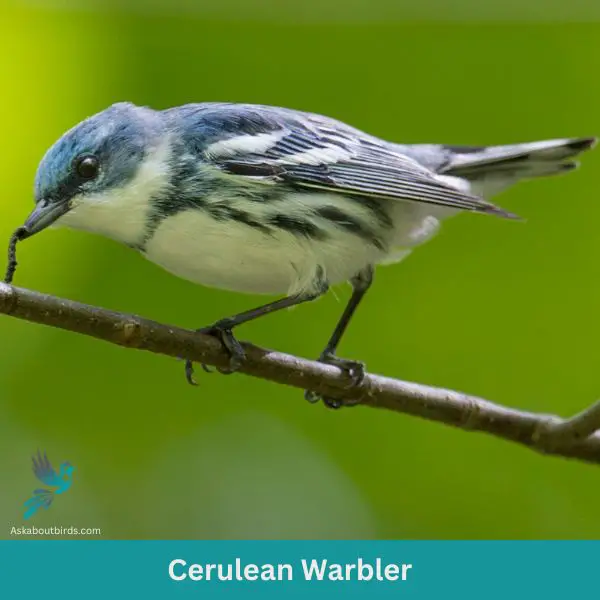
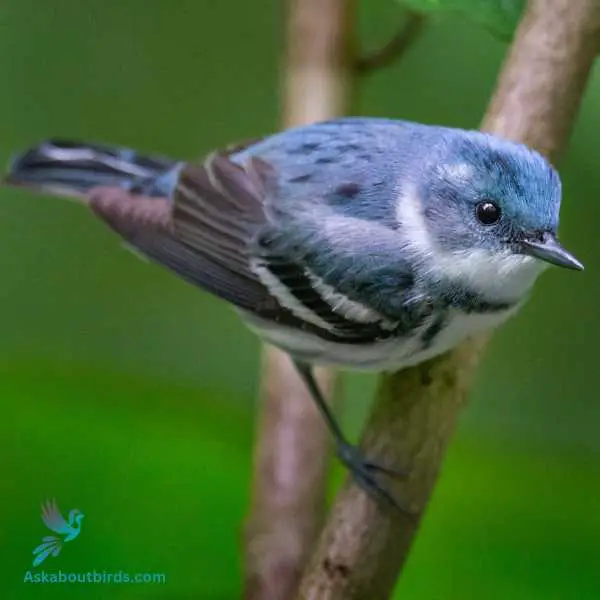
| Trait | Cerulean Warbler |
|---|---|
| Scientific Name | Setophaga cerulea |
| Length | 4.5 inches |
| Wingspan | 7.9-8.7 inches |
| Weight | 0.3-0.4 ounces |
The Cerulean Warbler is a striking songbird known for its sky-blue plumage and flitting movements in the forest canopy.
Appearance: Males boast a vibrant cerulean blue color on their upperparts, with streaked underparts, and a black necklace. Females have a more subdued bluish-green hue and lack the prominent black markings seen in males.
Diet: The diet of the Cerulean Warbler is predominantly made up of insects and spiders. They actively forage high in the treetops, gracefully maneuvering through leaves and branches.
Reproduction: Cerulean Warblers nest in the upper branches of tall deciduous trees. The female weaves a shallow cup-shaped nest and lays a clutch of 3-5 eggs.
Tree Swallow
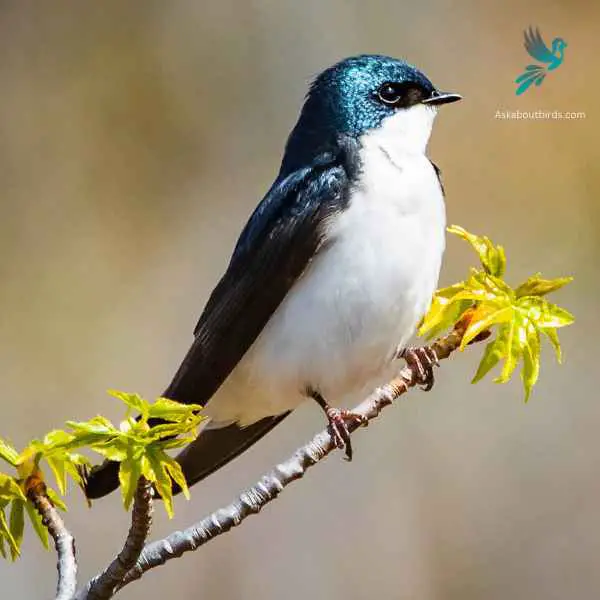
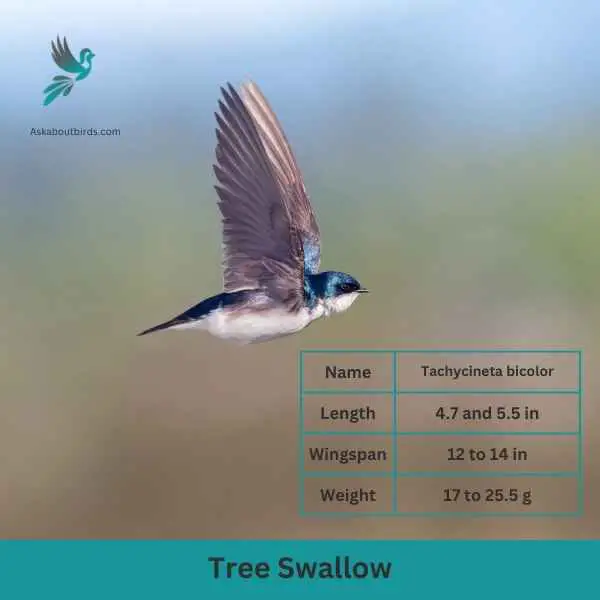
| Feature | Measurement |
|---|---|
| Scientific Name | Tachycineta bicolor |
| Length | 4.7 and 5.5 in |
| Wingspan | 12 to 14 in |
| Weight | 17 to 25.5 g |
The Tree Swallow is a graceful and agile bird, best recognized for its iridescent blue-green upperparts and sweeping flight patterns over open fields and water.
Appearance: The Tree Swallow is sleek with a streamlined body. The upperparts shine with a blue-green iridescence while the underparts are white. They possess long, pointed wings and a slightly forked tail, aiding in their agile flight.
Diet: Tree Swallows primarily feed on flying insects, skillfully catching them mid-air. During colder months when insects are scarce, they can switch to a diet of berries, particularly those of the bayberry, which other birds might find hard to digest.
Reproduction: Tree Swallows are cavity-nesters, typically choosing natural holes in trees or using bird boxes. They line their nests with feathers, creating a soft environment for the eggs. The female will lay a clutch of 4 to 7 white eggs.
Where to Spot Minnesota’s Blue Birds
The diverse landscape of Minnesota is a haven for bird enthusiasts. Here are some of the top locations in the state known for their abundant bird life, particularly blue birds:
- Sax-Zim Bog: This is one of the most famous birding spots in Minnesota, renowned for its variety of bird species, including blue birds. During the winter, it is also one of the best places to spot owls.
- Minnesota Valley National Wildlife Refuge: Located near the Minnesota River, this refuge offers a mix of wetlands, forests, and prairies that attract a wide range of bird species, including several types of blue birds.
- Itasca State Park: As the home of the headwaters of the Mississippi River, Itasca State Park provides a natural habitat for a variety of bird species. Its old-growth pine forests are particularly attractive to blue birds.
- Tamarac National Wildlife Refuge: This refuge is located in the transition zone between the deciduous forests of the south and the coniferous forests of the north, making it a unique habitat for a wide range of bird species, including blue birds.
- Boundary Waters Canoe Area Wilderness: This vast wilderness area in the Superior National Forest is a prime location for spotting a wide variety of birds, including blue birds, in their natural habitat.
| Neighboring States | Best Spots for Blue Birds |
|---|---|
| North Dakota’s Blue Birds | 1. Lostwood National Wildlife Refuge 2. Theodore Roosevelt National Park 3. Chase Lake National Wildlife Refuge |
| South Dakota’s Blue Birds | 1. Custer State Park 2. Badlands National Park 3. Black Hills National Forest |
| Iowa’s Blue Birds | 1. Neal Smith National Wildlife Refuge 2. Ledges State Park 3. Hawkeye Wildlife Management Area |
| Wisconsin’s Blue Birds | 1. Horicon National Wildlife Refuge 2. Crex Meadows Wildlife Area 3. Apostle Islands National Lakeshore |
FAQs on Blue Bird Species Found in Minnesota
What is the breeding range of the Belted Kingfisher?
The breeding range of the Belted Kingfisher covers a vast area of North America. They breed from Alaska and the Northwest Territories eastward to Newfoundland and Labrador, and southward to the southern United States, northern Florida, and central Mexico. Range maps from ornithological sources like the Cornell Lab can provide more detailed information. They prefer to nest site near bodies of water, as they feed primarily on fish. They excavate burrows in earthen banks, usually near the water’s edge.
What is the Bluebird Recovery Program?
The Bluebird Recovery Program is a conservation initiative aimed at helping to increase the population of bluebirds. The Eastern Bluebird, for instance, experienced a significant population decline due to habitat loss, competition for nesting sites, and other factors. The program involves monitoring bluebird populations, setting up and maintaining nest boxes, and educating the public on how to make their yards more bluebird-friendly. The program has been successful in increasing bluebird populations in many areas.
What is the nesting behavior of White-breasted Nuthatches?
White-breasted Nuthatches prefer deciduous forests, mixed and forest clearings. They nest in natural tree cavities or old woodpecker holes. Providing a nest box with a hole size of about 1.5 inches in diameter can encourage them to nest in your yard. They often line the inside of the nest with fur, bark, and other materials and sometimes smear the entrance with pitch or resin to deter predators and competitors. Sunflower seeds in bird feeders can also attract them.
What are some blue-colored birds?
There are several blue-colored birds, often referred to as blue beauties. Some notable ones include the male Eastern Bluebird, which has a bright blue color and a rusty red breast. The Indigo Bunting is another small bird that is entirely bright blue. Purple Martins, the largest North American swallows, have dark blue or purple plumage. The Blue-gray Gnatcatcher has a bluish-gray color on the upperparts and white underparts. And, the Belted Kingfisher has a blue-gray head and back.
